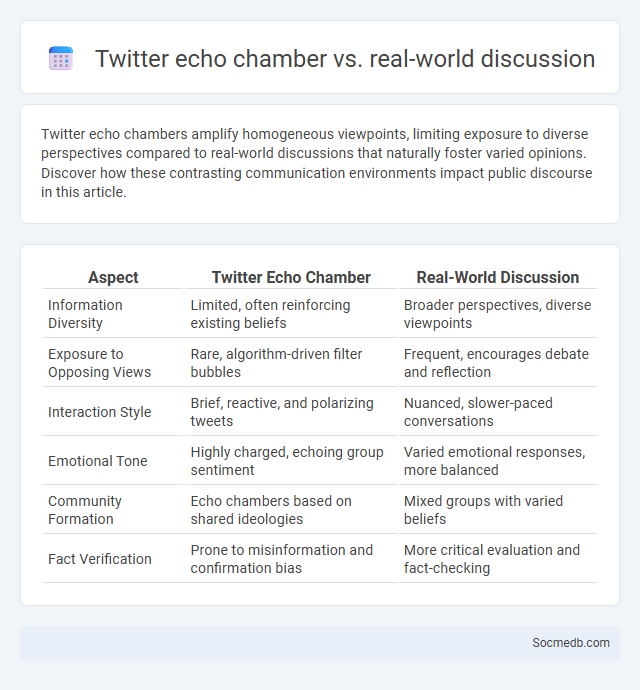
Photo illustration: Twitter echo chamber vs real-world discussion
Twitter echo chambers amplify homogeneous viewpoints, limiting exposure to diverse perspectives compared to real-world discussions that naturally foster varied opinions. Discover how these contrasting communication environments impact public discourse in this article.
Table of Comparison
| Aspect | Twitter Echo Chamber | Real-World Discussion |
|---|---|---|
| Information Diversity | Limited, often reinforcing existing beliefs | Broader perspectives, diverse viewpoints |
| Exposure to Opposing Views | Rare, algorithm-driven filter bubbles | Frequent, encourages debate and reflection |
| Interaction Style | Brief, reactive, and polarizing tweets | Nuanced, slower-paced conversations |
| Emotional Tone | Highly charged, echoing group sentiment | Varied emotional responses, more balanced |
| Community Formation | Echo chambers based on shared ideologies | Mixed groups with varied beliefs |
| Fact Verification | Prone to misinformation and confirmation bias | More critical evaluation and fact-checking |
Understanding the Echo Chamber Phenomenon
The echo chamber phenomenon on social media occurs when users are exposed predominantly to information and opinions that reinforce their existing beliefs, leading to increased polarization and reduced exposure to diverse perspectives. Algorithms on platforms like Facebook, Twitter, and Instagram prioritize content that aligns with user preferences, intensifying confirmation bias and limiting critical thinking. Understanding this effect is crucial for developing strategies that promote balanced discourse and mitigate misinformation in digital communities.
What Defines a Twitter Echo Chamber?
A Twitter echo chamber is defined by the repetitive sharing and amplification of similar opinions within a closed network of users, limiting exposure to diverse perspectives. Algorithms prioritize content that aligns with users' existing beliefs, reinforcing biases and polarizing discussions. This environment fosters homogeneous viewpoints, reducing critical thinking and hindering meaningful dialogue outside the echo chamber.
Real-World Discussions: Dynamics and Diversity
Social media platforms enable dynamic real-world discussions by connecting diverse communities and fostering authentic exchanges on current events. Your engagement amplifies diverse perspectives, enriching conversations with varied cultural, social, and political viewpoints. These interactive dialogues facilitate a deeper understanding of complex issues through real-time feedback and collective insight.
How Social Algorithms Amplify Twitter Echo Chambers
Social algorithms on Twitter prioritize content that aligns with users' existing beliefs, reinforcing cognitive biases and limiting exposure to diverse perspectives. These algorithms use engagement metrics such as likes, retweets, and comments to amplify polarizing or sensational content, intensifying echo chamber effects. As a result, users increasingly encounter homogeneous viewpoints, which exacerbates social polarization and hinders constructive dialogue.
Echo Chamber Effects on Public Opinion
Echo chamber effects on social media significantly influence public opinion by reinforcing users' existing beliefs through algorithm-driven content curation, limiting exposure to diverse perspectives. This phenomenon intensifies polarization and reduces critical thinking as You engage primarily with like-minded communities, shaping your worldview in a feedback loop. Understanding these dynamics is crucial for fostering balanced discussions and mitigating misinformation across digital platforms.
Comparing Twitter Echo Chambers to Real-World Conversations
Twitter echo chambers create insulated environments where users interact primarily with like-minded individuals, limiting exposure to diverse perspectives. In real-world conversations, you encounter a broader range of opinions, fostering more dynamic and unpredictable interactions. This contrast affects how your beliefs are reinforced or challenged, shaping your understanding of social and political issues.
Psychological Roots of Echo Chamber Behavior
Echo chamber behavior on social media stems from cognitive biases such as confirmation bias and selective exposure, where users prefer information that aligns with their existing beliefs and values. This psychological tendency is reinforced by algorithm-driven content curation that amplifies homogeneous perspectives, leading to increased polarization and reduced critical thinking. Understanding these cognitive and algorithmic dynamics is crucial for addressing misinformation and promoting diverse discourse online.
Consequences of Echo Chambers for Society
Echo chambers on social media reinforce users' pre-existing beliefs by limiting exposure to diverse viewpoints, which can deepen societal polarization and hinder constructive dialogue. Your critical thinking and willingness to seek varied perspectives are essential to counteract the narrowing effects of algorithm-driven content curation. This phenomenon can also contribute to misinformation spread, as communities validate false information without external scrutiny.
Strategies to Break Out of Digital Echo Chambers
Breaking out of digital echo chambers requires diversifying your social media feeds by following a wide range of voices and perspectives across platforms like Twitter, Facebook, and Instagram. Engaging critically with content and using tools such as algorithm settings or third-party apps can help reduce filter bubbles. Your intentional exposure to varying viewpoints enhances information accuracy and promotes balanced online discourse.
Fostering Authentic Dialogue Beyond Social Media
Fostering authentic dialogue beyond social media requires creating safe spaces where individuals can engage in meaningful conversations without digital distractions. Emphasizing face-to-face interactions and community events cultivates trust and genuine connections, countering the superficiality often found online. This approach enhances emotional intelligence and promotes deeper understanding across diverse perspectives.
 socmedb.com
socmedb.com